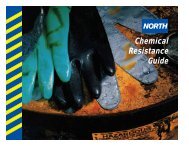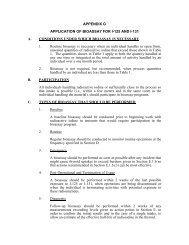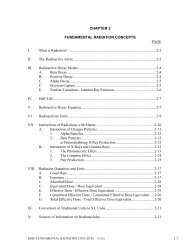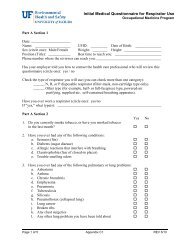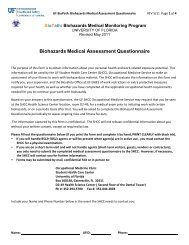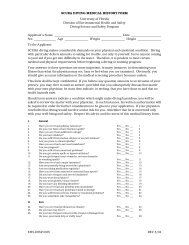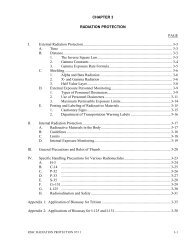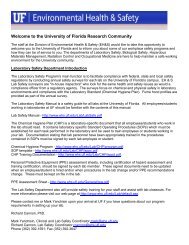Have limited toxicological data applicable to human exposures.Exposure risks are primarily from inhalation, ingestion, and accidental injection. Dried/powderedforms are particularly hazardous for their inhalation potential and tendency for electrostaticattachment to gloves, weighing spatulas, etc.Most are stable proteins (although trichothecene mycotoxins from fungi are carbohydrates) thatrequire harsh “disinfectants” for inactivation.Risk factors to consider for working with biological toxins: Aerosol generating procedures (e.g. vortexing, grinding, centrifuging, intra-nasal inoculation <strong>of</strong>animals, sonication). Utilization <strong>of</strong> concentrated stocks or large quantities <strong>of</strong> toxins. Work with powdered or dried toxins. Work with highly lethal toxins or highly purified forms <strong>of</strong> less lethal toxins. Use <strong>of</strong> needles or sharps in experiments with toxins.kg body weight (see tables 4, 5) requires:Project registration with the Biosafety Office (See Registration Forms)Inventory control log and signage.Standard Operating ProceduresSecurity measuresProper disposalIn general, BSL-2 containment, although a risk assessment may dictate other precautions.Some toxins are controlled for export and regulated as select agents (Table 6) requiring stringentregulations for possession, use, or transfer <strong>of</strong> non-exempt amounts (Table 7).Resources: “<strong>Safety</strong> and health Considerations for Conducting Work with <strong>Biological</strong> Toxins”, Johnson,Mastnjak, and Resnick; Applied Biosafety, 6(3) pp. 117-135, 2001 Biosafety in Microbiological and Biomedical Laboratories (BMBL) 5th EditionMammalian Cell CulturesLaboratorians who handle or manipulate human, non-human primate, or other mammalian cell lines andtissues are at risk for possible exposure to potentially infectious latent and adventitious agents that maybe present in those cells and tissues. The potential for human cell lines to harbor a bloodborne pathogenled OSHA to include human cell lines in the final rule unless they were specifically tested for, anddocumented to be free <strong>of</strong>, human bloodborne pathogens.There also is evidence <strong>of</strong> accidental transplantation <strong>of</strong> human tumor cells to healthy recipients, indicatingthat these cells are potentially hazardous to the laboratory workers who handle them. Further, human andanimal cell lines that are not well characterized or are obtained from secondary sources may introduce abiohazard to the laboratory. Note that cell lines purchased from commercial vendors historically were notroutinely tested for viruses, including those that may be human or animal pathogens. However, ATCCnow tests every lot <strong>of</strong> every human cell line manufactured after January 4th, 2010 for common humanviral pathogens: HIV, HepB, HepC, HPV, EBV and CMV. For additional information please see the FAQsection <strong>of</strong> the ATCC website. Biosafety Level 2 is appropriate when work is performed with all human celllines and any mammalian cell line that has not been well characterized or where the presence <strong>of</strong> aninfectious agent may be unknown.Human Blood and Other Potentially Infectious MaterialHuman blood and other potentially infectious material (OPIM) may contain infectious agents including, butnot limited to, human immunodeficiency virus (HIV), hepatitis B virus (HBV), and hepatitis C virus (HCV).19
Other potentially infectious materials (OPIM) are defined as: The following human body fluids: semen, vaginal secretions, cerebrospinal fluid, synovial fluid,pleural fluid, pericardial fluid, peritoneal fluid, amniotic fluid, saliva in dental procedures, any bodyfluid that is visibly contaminated with blood, and all body fluids in situations where it is difficult orimpossible to differentiate between body fluids. Any unfixed tissue or organ (other than intact skin) from a human (living or dead). HIV or HBV-containing cell or tissue cultures, organ cultures, culture medium or other solutions.Blood, organs or other tissues from experimental animals infected with HIV or HBV.ContainmentAs with other biological hazards, combinations <strong>of</strong> safe work practices, safety equipment, administrativecontrols, and laboratory facility design/features are applied to minimize risks. Biosafety Level 2 isappropriate for work with human blood and OPIM. Should an exposure occur, thorough cleansing <strong>of</strong> theexposed area followed by immediate medical attention is required. UF has the Needle Stick Hotline (1-866-477-6824) in place for all BBP exposures and evaluates affected employees for treatment and postexposureprophylaxis at the Occupational Medicine Clinic located in room D2-49.UF Bloodborne Pathogen (BBP) ProgramTo curb the spread <strong>of</strong> these diseases in occupational settings, the Occupational <strong>Safety</strong> and HealthAdministration (OSHA) Bloodborne Pathogens Standard (29 CFR 1910.1030) was implemented in 1992.The <strong>University</strong> <strong>of</strong> <strong>Florida</strong> follows this standard to protect staff, students, volunteers, and affiliates withpotential exposure to human blood or OPIM as part <strong>of</strong> their work or participation in a <strong>University</strong> program;these individuals are required to participate in the UF Bloodborne Pathogen Program. The <strong>University</strong> <strong>of</strong><strong>Florida</strong> has a university-wide Exposure Control Plan and individual departments have site-specificexposure control plans in place. Laboratory or clinic-specific Standard Operating Procedures are requiredfor work with human blood or OPIM. To facilitate compliance a template is available (see link above).Compliance with the UF Bloodborne Pathogen (BBP) program requires initial and annual BBP training,documented hepatitis B vaccination (or documented declination <strong>of</strong> the vaccine) as well as annual trainingon the proper segregation, handling, and disposal <strong>of</strong> biomedical waste. The training must be site-specific.To facilitate this, departments have a designated BBP trainer. Contact the Biosafety Office to identify yourdepartmental trainer. For more information on the UF BBP Program, see the Occupational MedicinePrograms section <strong>of</strong> this manualClinical LaboratoriesClinical laboratories typically receive clinical specimens with requests for a variety <strong>of</strong> diagnostic andclinical support services. Generally, the infectious nature <strong>of</strong> clinical material is unknown, and specimensare <strong>of</strong>ten submitted with a broad request for microbiological examination for multiple agents (e.g., sputasubmitted for "routine," acid-fast, and fungal cultures). It is the responsibility <strong>of</strong> the laboratory director toestablish standard procedures in the laboratory that realistically address the issue <strong>of</strong> the infective hazard<strong>of</strong> clinical specimens.ContainmentExcept in extraordinary circumstances (e.g., suspected hemorrhagic fever), the initial processing <strong>of</strong>clinical specimens and serological identification <strong>of</strong> isolates can be performed safely at BSL-2, therecommended level for work with bloodborne pathogens such as HBV and HIV. The containmentelements described in BSL-2 are consistent with the OSHA BBP standard. This requires the use <strong>of</strong>specific precautions with all clinical specimens <strong>of</strong> blood or other potentially infectious material (UniversalPrecautions). Additionally, other recommendations specific for clinical laboratories may be obtained fromthe Clinical Laboratory Standards Institute http://www.clsi.org/. The CDC has also published Guidelinesfor Safe Work Practices in Human and Animal Medical Diagnostic Laboratories; Recommendations <strong>of</strong> aCDC-convened, Biosafety Blue Ribbon Panel.BSL-2 recommendations and OSHA requirements focus on the prevention <strong>of</strong> percutaneous and mucousmembrane exposures to clinical material. Primary barriers such as biological safety cabinets should beused when performing procedures that might cause splashing, spraying, or splattering <strong>of</strong> droplets.<strong>Biological</strong> safety cabinets also should be used for the initial processing <strong>of</strong> clinical specimens when the20
- Page 1: UNIVERSITYBiosafetyManual2014OFFLOR
- Page 5 and 6: Hurricane Watch ...................
- Page 7 and 8: Authority & ResponsibilitiesBy auth
- Page 9 and 10: All projects involving recombinant
- Page 11 and 12: Tools for Risk AssessmentBoth the N
- Page 13 and 14: The risk assessment will also deter
- Page 15 and 16: assessments and tests/immunizations
- Page 17 and 18: protection of workers and the envir
- Page 23 and 24: Integration of rAAV genomic sequenc
- Page 26 and 27: from fowlpox virus) are most widely
- Page 28 and 29: S+/L- assay: Vector stocks are ampl
- Page 30 and 31: Kenneth Cornetta, Jing Yao, Aparna
- Page 32 and 33: material. The catalyst for increase
- Page 34: Engineering ControlsThese devices a
- Page 38: PPE to protect eyes and face is use
- Page 41 and 42: DisinfectantsDisinfectants are chem
- Page 43 and 44: Formaldehyde Gas (from heating para
- Page 45 and 46: Call Building Services, 294-5500, t
- Page 47 and 48: Autoclave use log must be available
- Page 49 and 50: After the disaster has occurred, de
- Page 51 and 52: Workplace ViolenceAll threats and o
- Page 53 and 54: Account for coworkersWait for any i
- Page 55 and 56: 4. The physician may wish to consul
- Page 57 and 58: Spill Outside the LaboratorySafe tr
- Page 59 and 60: An emergency room should only be us
- Page 61 and 62: staff notifies the PI of any person
- Page 63 and 64: Departments: Assist EH&S in identif
- Page 65 and 66: Investigational New Drug (IND) Vacc
- Page 67 and 68: Transport of Biological Materials o
- Page 69 and 70:
All human, animal, or plant pathoge
- Page 71 and 72:
Special IssuesHIV Research Laborato
- Page 73 and 74:
Symptoms suggestive of B virus infe
- Page 75 and 76:
tuberculosis are a potential source
- Page 77 and 78:
Table 2. Summary of Recommended Bio
- Page 80 and 81:
Table 4: Select Agents and Toxins79
- Page 82 and 83:
Table 6: Summary of NIH Guidelines;
- Page 84 and 85:
Section Subsection Research Applica
- Page 86 and 87:
App C-IVKluyveromyces Host-Vector S
- Page 88 and 89:
Table 8: Summary of Biosafety of Vi
- Page 90 and 91:
ResourcesBiosafety Resources: http:
- Page 92 and 93:
OCCMEDOPIMOSHAPAPRPIPPEPPQPSDSRACrD
- Page 94 and 95:
ParenteralPathogenPathogenicityPers
- Page 96 and 97:
Plant, Plant Pests, Noxious Weeds,a
- Page 98 and 99:
Select Agent RegulationsAnimal, Ani
- Page 100 and 101:
Transportation RegulationsTransport




